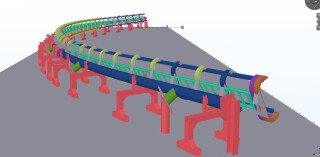Ever since Abraham Darby built his iron bridge over the River Severn in Shropshire more than 200 years ago, the UK has maintained a reputation for excellence in structural engineering.
Today steel, rather than cast iron, is the material of choice for strong, slender, sophisticated structures such as bridges and sports stadia. And the UK remains a significant player on the world stage.
However, the UK’s reputation for structural steelwork peaked in the mid- to late-1980s – or so says Jarrod Hulme, managing director of Bolton-based fabricator Taziker Engineering Services, the steelwork division of Taziker Industrial.
This article was first published in the June 2020 issue of The Construction Index Magazine. Sign up online.
Hulme is a relatively new recruit at Taziker – but he’s got a 30-plus-year pedigree in the steelwork sector and he speaks from experience.
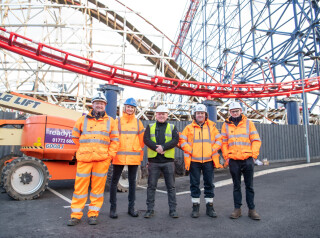
Bolton born-and-bred, Hulme spent most of his career with the town’s pre-eminent steelwork firm, Watson Steel, and then north-Yorkshire-based Severfield following the latter’s acquisition of Watson in 2001.
Thirty years ago, Watson Steel was possibly the most admired steelwork firm in the industry – and with good reason. The company seemed to be providing the steelwork for every landmark infrastructure project worldwide – especially in the so-called ‘tiger economies’ of southeast Asia.
From the £700m, Richard Rogers-designed Kansai International Airport in Japan to Norman Foster’s Hong Kong International Airport at Chek Lap Kok, Watson Steel was delivering the kind of complex, high-quality steel structures demanded by the most ambitious architects.
Watson, in common with several other leading British steelwork fabricators, was able to do this largely because it was among the first companies in the construction industry to embrace computer-aided design and manufacturing and 3D modelling. “We were at the cutting edge,” says Hulme. “Over 15 years ago, Watson pioneered the use of Tekla Structures and we found a way of exporting data from total stations into the software to create 3D models.”
Watson’s first major success with this technology was in 1997 with 350 tonnes of steel track designed and fabricated for the Disney Corporation for a mile-long rollercoaster in California. “I built several rollercoasters when I was with Watson,” says Hulme; “I worked on the Big One at Blackpool when I was still on the shop floor.” Which brings us to Taziker, Hulme’s new employer.
Earlier this year, Taziker completed a contract to design and fabricate 45m of new track to replace a worn-out section of the 26-year-old Big One. Designed by US specialist Arrow Dynamics and with steelwork by Watson Steel, the ride was, at 71m, the tallest and fastest rollercoaster in the world when it opened to the public in 1994. Subsequent developments mean it is now merely the tallest rollercoaster in the UK.
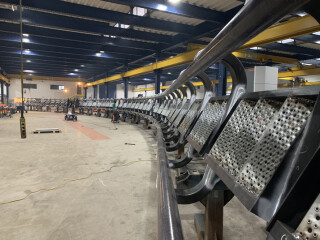
Though not as instantly recognisable as the Blackpool Tower, the Big One has nonetheless become an established landmark on the resort’s skyline. For Hulme personally, the recent refurbishment contract was a poignant return to past triumphs; but for Taziker it marks an exciting step in a new direction.
Taziker started life in the 1960s as a painting contractor, focusing on commercial projects such as retail, leisure and office premises. Over the years the business diversified into industrial protective coatings, working on structures including the Tyne Bridge and Jodrell Bank telescopes.
In the mid-1990s Taziker repositioned itself at Taziker Industrial, with a focus on structural repair and refurbishment. This is still the company’s special area of expertise and, indeed, one of its most recent triumphs has been the painstaking restoration of the structure that started it all – Abraham Darby’s cast iron bridge over the Severn (see TCI magazine, Dec-Jan 2018/19).
Nevertheless, the past 20 years have seen transport infrastructure – and especially rail – become the company’s main source of income. By 2007 rail accounted for almost 90% of group turnover.
With so many eggs in one basket, the company decided to diversify and thus open up more opportunities with customers in other sectors. As a principal contractor for Network Rail, Taziker regularly sub-let packages of work to scaffolding firms and steelwork fabricators and so it made sense to integrate these two disciplines into its business portfolio.
Taziker subsequently acquired two scaffolding contractors, Network Scaffolding and Project Scaffolding. Then it set up its own in-house steelwork fabrication and repair division, Taziker Engineering Services. All it needed then was someone with the necessary knowledge and expertise to come in and run it.
Over at Severfield, Jarrod Hulme was ready for a change of direction. He’d been at Severfield, and Watson before that, for 31 years and had risen from the shop floor to the post of senior project manager. His speciality was engineering the sort of complex fabrications that are almost impossible to manufacture from 2D drawings. His CV included structures such as the Ordsall Chord in Manchester and the ArcellorMittal “Orbit” at the Olympic site in London.
But despite his track record, Hulme hadn’t yet made it to director level – a role which he felt he had earned. So when, about 18 months ago, Hulme got a call from Taziker CEO Paolo Benedetto, he was all ears.
“He said he wanted to build a new steelwork business and he wanted it to be the best,” says Hulme. “He wanted to create another Watson Steel built on Watson DNA – and that’s why he was speaking to me.”
Hulme didn’t take much persuading. Benedetto was offering him the opportunity to create his own steelwork operation; and Hulme was eager to prove that he could do it. With a new and spacious workshop acquired in nearby Heywood, Hulme thought he could mould the new Engineering Services division the way he wanted it.

“When I started, they already had jobs in the workshop. It was all refurbishment and condition-led repairs, the biggest of which was the Ironbridge restoration,” says Hulme. “We weren’t doing any high-tech new-build work at that stage.”
That quickly changed when managers at his old employer, Severfield, contacted Hulme about the Blackpool project. “I don’t know why they didn’t want the contract – maybe it was too small for them. Maybe it was too complex,” says Hulme. For him, though, it was perfect.
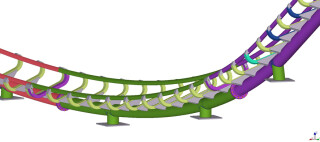
Asked what he needed to tackle this sort of job, Hulme demanded the latest Leica total stations, the latest edition of Tekla Structures and cloud-point technology – BIM-enabled 3D laser scanning that quickly generates a highly-detailed 3D model of a structure.
Hulme used Trimble SX10 scanning equipment to scan the Blackpool ride and then the old track sections were removed during the 2019/20 off-season. Taziker then built a fabrication jig in its Heywood factory to support the new steelwork while it was assembled in one 45m length.
Using the latest technology enabled Taziker to fabricate compound curves to very precise tolerances, says Hulme: “We were able to create proper radiuses – natural curves – to improve the geometry and create a smoother ride,” he explains.
“The Big One track replacement is always extremely challenging in terms of matching geometry between existing and new track sections,” says Alex Payne, technical director at Blackpool Pleasure Beach. “But thanks to the level of detail involved in the planning and execution of the work it has been a relatively seamless project due to the professionalism and skillset at Taziker.”
Other jobs undertaken by Taziker Engineering Services have included the design and fabrication of a new pedestrian bridge at Blackpool North railway station and a new link-bridge, under subcontract to Severfield, at Manchester Airport terminal 2 for main contractor Galliford Try.
Last year the company also designed and fabricated a replacement footbridge for Rochdale Council, again using the latest technology. And modest though this structure is, Hulme has high hopes for further orders.
“You see the same standard footbridge over dual carriageways everywhere,” he says. “Well, this is a new standard design. We took out all the concrete and used a GRP deck. Now we can market this as our own design – it’s our bridge,” he declares.
Meanwhile Taziker’s dependence on the rail sector is still considerable (it has recently won a place on the framework for new structures and repair work on the proposed Transpennine Upgrade between Manchester and Leeds). But it is steadily reducing its reliance on rail infrastructure work.
Hulme says that rail will contribute less than 75% of group turnover this year and his aim is to maintain this workload while gradually developing in other sectors until rail constitutes only around 40%.
And what Hulme relishes more than anything is the opportunity to engineer complex fabrications – structures akin to the Big One at Blackpool. In fact he believes that the door is open to any ambitious steelwork firm with the necessary technical capabilities to corner the market here.
Most steelwork fabricators now focus on profitable but less ambitious bread-and-butter contracts, says Hulme, and the kind of technical tours de force exhibited by Watson Steel at Kansai and Chek Lap Kok are becoming a rarity: “Today it’s less technical, more volume,” he says.
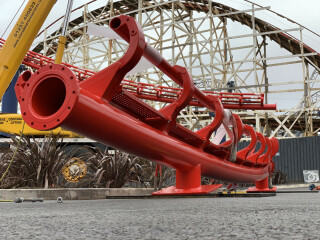
Like everybody else, Taziker has had to adjust to the constraints of the Covid-19 lockdown, but Hulme’s ambitions are not daunted. “Yes, some sites have closed, but some repair jobs are deemed essential so we’ve kept going,” he says.
“I’ve had to let all our agency staff go and only two people are allowed in the canteen at any one time, but otherwise we’re OK. We’ve got a huge space here – we’re working at 5m social distances just because we can.
“I’m working from home, but it’s been no problem for me at all. I can run my team as easily as if we were all in the office,” he says.
And despite his desire to diversify, he’s grateful that there is still plenty of work waiting in the rail industry pipeline: “It’s always infrastructure that builds the economy back up after a recession and I think it’ll be key to the recovery after this.”
This article was first published in the June 2020 issue of The Construction Index Magazine
UK readers can have their own copy of the magazine, in real paper, posted through their letterbox each month by taking out an annual subscription. Click for details.
Got a story? Email news@theconstructionindex.co.uk

